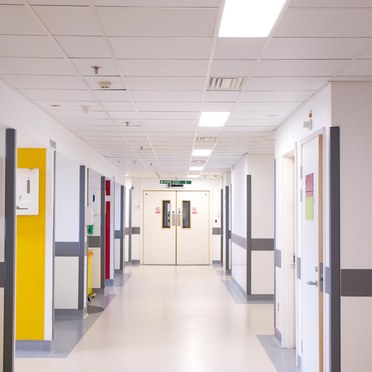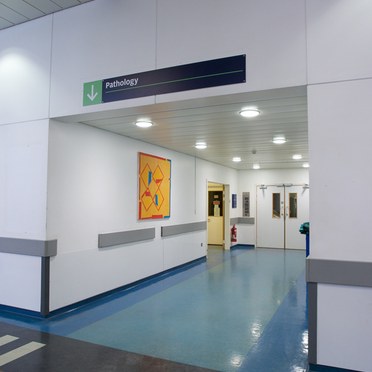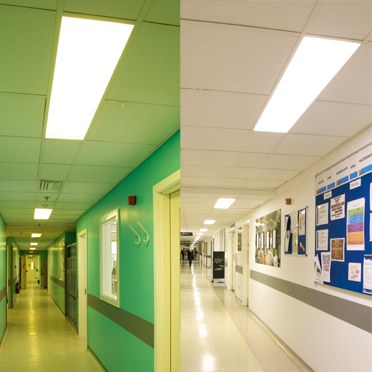Chelsea & Westminster Hospital, UK
- Lamp efficacy
Lamp efficacy
improved luminaire efficacy resulting in significant energy reduction.
- Ballast classification
Ballast classification
Controlling the electricity supply to the lamp (Energy Efficiency Index).
- Luminaire distribution
Luminaire distribution
Improved luminaire distribution resulting in greater luminaire spacings.
- System efficacy
System efficacy
LED upgrade resulting in significant energy reduction.
- Presence/absence detection
Presence/absence detection
Providing lighting only when it’s needed.
- Daylight detection
Daylight detection
Reducing waste light during daylight hours.
- Constant illuminance
Constant illuminance
Producing the correct lighting levels for the duration of the maintenance period.
- Task-scene setting
Task-scene setting
Zoned lighting controls provide additional enargy savings
- Timed off
Timed off
Automatic cut-off to turn all lights off during unoccupied hours.
- Task lighting
Task lighting
Providing the required levels of light onto the task with minimal spill light reduces over-lighting of surrounding areas, providing the correct light levels to all areas whilst minimising energy use.
- Zoning of lighting
Zoning of lighting
Zoning lighting in accordance to occupancy patterns or window location.
- Maintenance schedule
Maintenance schedule
Tailoring maintenance schedules in accordance to product age, performance and environment.
- Waste light
Waste light
Eliminating waste light which does not hit the intended target.
- Reflectance
Reflectance
Taking advantage of light which is reflected from the surface within the space.
- Visible smart metering
Visible smart metering
Enabling results of actions to be quickly seen as increased or decreased energy use to encourage responsible energy consumption.
For the UK National Health Service (NHS), a sustainable health and care system that works within the available environmental and social resources is the key to protecting and improving health now and for future generations.
This means working to reduce carbon emissions, minimising waste and pollution, making the best use of scarce resources, building resilience to a changing climate and nurturing community strengths and assets. Chelsea and Westminster Hospital NHS Foundation Trust is one of many NHS facilities with a series of new build and refurbishment projects.
Lighting targeted for significant energy reduction
Supported by Ferguson Brown Consultants, Chelsea and Westminster obtained funding to upgrade to LED lighting based on predicted energy and CO2 reductions through the life of each installation. The need to replace existing fixtures point for point with minimal construction work was essential to the project as all areas were live environments so patient care and consideration was paramount.
Additionally, the timeline to design, manufacture and install a solution was a critical factor to be considered as deadlines were in place to access the funding of the project.
The right partners, solutions and commitment to excellence
Thorn were selected to provide the product solution based on a mix of standard, modified and bespoke fixtures, carefully selected to meet the stringent requirements of the project. Standard products included Chalice LED downlights for circulation areas, College LED for corridors and Omega LED for the patient wards. Local controls were also built into the project, helping to maximise the energy savings and provide additional functionality of the spaces.
Bespoke architectural solutions were used in more challenging areas such as the atria and staircases. The existing indirect reflector fixtures and suspended circular fixtures in these spaces were originally designed to complement the building architecture and are an important feature for the trust to keep and maintain the building identity. Therefore the refurbishment and upgrade exercise was required to replace the existing compact fluorescent sources with LED. With the timescales being so stringent on the project, the additional prototyping and testing of these bespoke solutions had to be built into the programme.
Setting the scene for the future
The upgrades completed in this phase of the project resulted in a 42% reduction in energy consumption with a payback of less than 5 years with the additional benefit of reduced maintenance not only a financial benefit for the Trust but also playing a major part in minimised disruption in the 24 hour care they provide and maximising safety through low maintenance lit environment.
Based on the success of this first phase, Chelsea and Westminster are now planning the remaining 60% of the refurbishment programme.



